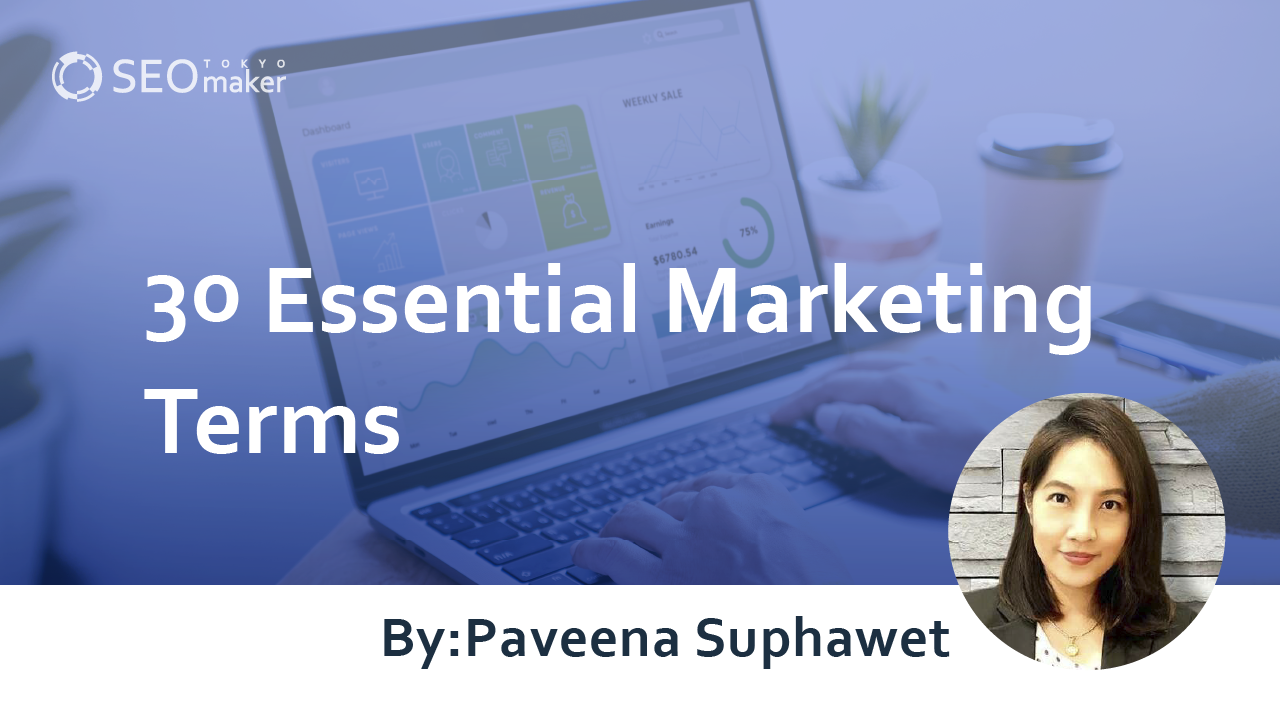30 Essential Marketing Terms You Need to Know Right Now! A Handy Glossary for Practical Use
contents

If you are looking to learn about marketing, the abundance of terminology can be overwhelming, leaving many feeling puzzled.
That is why, this time, we have carefully selected 30 particularly important marketing terms. If you are someone who wants to start by learning only the essential terms in marketing, be sure to refer to this article.
Basic Marketing Terminology
Let us introduce the basic terms you should learn first in marketing.
Marketing
Marketing is about capturing the needs of the market, creating a system for your own products to sell. It involves understanding the products or services that modern consumers are looking for and delivering them in the most optimal way to maximize sales.
Needs
Needs refer to the state in which customers feel it is a necessity. For example, wanting household appliances that make cleaning easier is a need. Capturing these needs is highly valued in marketing.
Customer Value.
Customer value
Customer value refers to the value recognized by customers for the products or services offered by a company. When this customer value exceeds the level desired by customers, it leads to customer satisfaction and results in the purchase of the company’s products by consumers.
On the other hand, if customer value does not meet the level desired by customers, the company’s products will not be purchased continuously. It is worth noting that customer value naturally fluctuates depending on the price. Generally, as the price increases, customer value also increases.
Market
The market is an abstract space where buyers exist. In the world of economics and securities, the term ‘market’ often refers to a space where buyers and sellers exist. However, strictly speaking, in marketing, it is assumed that there is only the buyer’s space.
Brand
The image that consumers have of a company’s products is referred to as the ‘brand.’ Simply put, it is the state where consumers become fans of the company’s products. If consumers can create reasons to purchase the company’s products, it becomes a differentiation from competitors, allowing the products to sell even at a relatively higher price.
STP
Segmentation, Targeting, and Positioning (STP) is the process of segmenting the market and targeting specific markets. STP is derived from the following three initials.
<What is STP?>
-Segmentation: Segmenting the market and grouping it based on similar characteristics.
-Targeting: Focusing on specific markets.
-Positioning: Clearly defining a position in the targeted market.
STP Analysis
In STP, by clearly defining the market the company is targeting and its position in that market, it becomes possible to effectively develop the market.
Marketing Research Terminology
In marketing, conducting research on markets and customers, known as ‘marketing research,’ is extremely important. Let us take a look at some key terms in marketing research.
Marketing Research
The scientific investigation conducted in marketing methods to maximize sales is referred to as ‘marketing research.’ It’s the initial method conducted when starting a new business or revising existing ones, and it is a phase that can be considered the cornerstone of marketing.
Qualitative Research.
Research that examines words or sentences is called ‘qualitative research.’ For example, when a company selling vacuum cleaners interviews customers to gather information like ‘it’s comfortable to use and I love it,’ that is qualitative research.
Focus Group Interviews
A primary research method in qualitative research is ‘focus group interviews.’ It involves gathering specific groups into one space and conducting interviews in a discussion format.
Focus group interviews are highly beneficial for product development and improvement because they allow access to users’ true feelings.
Observational Research
Observational research involves closely observing user behavior to gather information about purchasing habits. By visiting actual purchase locations and observing each user’s behavior, you can uncover underlying purchasing psychology.
This is a recommended research method for companies that require more than superficial information, such as surveys.
Quantitative Research
Research that reveals numerical data is called ‘quantitative research.’ By quantifying aspects like ‘product awareness,’ ‘service usage rates,’ or ‘the number of stores with good service,’ you can obtain objective information.
Online Surveys
A type of quantitative research, online surveys involve collecting data over the internet, which is currently the mainstream method. By offering incentives like money or points in exchange for completing surveys, internet users provide data such as product awareness or usage rates.
Both researchers and respondents find this method convenient, making it one of the commonly used techniques in quantitative research.
Telephone Surveys
A type of quantitative research, telephone surveys involve gathering information directly through phone calls. When conducting telephone surveys for quantitative research purposes, questions are used to quantify aspects like product awareness or satisfaction, allowing for data collection.
This method is primarily suitable for interviewing the senior demographic, which may have lower internet usage rates.
Marketing Mix Terms
After understanding the market and customers through marketing research, and setting the target with STP, the next step is to determine specific strategies with the marketing mix.
Marketing Mix
Combining multiple strategies to maximize customer attraction is called the ‘marketing mix.’ It falls under the ‘implementation strategy’ and clarifies ‘what kind of product to deliver to customers and in what manner.
4P Analysis
A method for determining detailed strategies and specific content is called ‘4P analysis.’ It is a framework for analyzing from the ‘buyer’s perspective.’ The ‘P’ in 4P analysis stands for the following four initial letters.
What is 4P Analysis?
Product: Clarifying ‘strengths and weaknesses of our products’ and ‘services that can differentiate from competitors.
Price: Analyzing ‘pricing strategies of competitors for similar products’ and ‘whether increasing or decreasing prices can increase sales.
Promotion: Clarifying ‘advertising strategies used by our company’ and ‘identifying promotions superior to ours among competitors.
Place: Identifying ‘distribution routes to reach customers’ and ‘effective distribution routes used by competitors.’
By analyzing our products from these four perspectives, hypotheses can be made about ‘what points are superior to competitors?’ This helps clarify our company’s unique approach.
4C Analysis
<What is 4C Analysis?>
4C analysis is a method used when starting new businesses or revising existing ones. It is a framework for analyzing from the ‘seller’s perspective.’ The ‘C’ in 4C analysis stands for the following four initial letters.
Customer Value: Clarifying ‘how much value customers recognize in our products.
Cost: Calculating ‘costs incurred until our products reach customers.
Convenience: Analyzing ‘whether customers can easily access our products’ and ‘whether there are any inconveniences due to product or service shortages.
Communication: Clarifying ‘how well communication with customers is established.’ Communication includes not only ‘direct words’ but also ‘inquiry desks’ and ‘social media.’
By analyzing our products from the seller’s perspective, it becomes possible to leverage our strengths when starting new businesses or identify weaknesses in existing ones.
7P Analysis
The 7P analysis is a framework that allows for even more detailed analysis than the 4P analysis. In addition to the 4Ps, the 7P analysis includes analysis of the following three Ps:
<Unique Elements of 7P Analysis>
–Physical Evidence: Providing customers with a sense of security and safety. In today’s world, without assurance of safety and security, products are unlikely to be purchased.
–Process: Refers to how services are provided to customers. The more robust the service process, the higher the customer satisfaction.
–People: The employees and staff who provide products or services. Analyzing salespersons from the buyer’s perspective, including their attitude and sales pitch.
The characteristic feature of 7P analysis is its focus on ‘services’ and its analysis of both our company and competitors. If services can be provided in a better way, increasing repeat customers should not be difficult.
Digital Marketing Terms
Among the various aspects of marketing, let us explain the terms related to the essential ‘digital marketing’ in today’s world.
Digital Marketing
Among marketing efforts, creating a system for selling our products using digital technology is called ‘digital marketing.’ Digital encompasses not only ‘websites’ but also ’emails,’ ‘social media,’ and ‘digital signage.’
Omnichannel
A marketing technique that integrates multiple sales channels and merges offline and online is called ‘omnichannel.’ One famous example of omnichannel is the comprehensive online shopping site ‘Omuni7’ by Seven & i Holdings.
Through Omuni7, Seven & i Holdings created a system where products purchased online could be picked up at Seven-Eleven stores, thus integrating online and offline. This created a positive cycle where online purchases led to motivations for offline visits.
Triple Media
Triple Media is a concept in digital marketing that categorizes media into three types. Triple Media can be classified into ‘Owned Media,’ ‘Paid Media,’ and ‘Earned Media.’
Owned Media
‘Owned Media’ refers to media that you (your company) own. Content marketing, a marketing method that nurtures customers through content and leads them to conversion, is largely carried out using this Owned Media.
To create Owned Media, you can use existing CMS like ‘WordPress,’ or you can rely on website development companies for creation.
Paid Media
Paid Media’ refers to media where you pay for advertising placement. Examples include ‘TV,’ ‘Radio,’ ‘Magazines,’ and also ‘Web Advertising.’
Paid Media, which reaches a large number of users, offers the advantage of guaranteeing readers to a certain extent just by placing the advertisement. For companies looking to increase awareness in the early stages of promotion, Paid Media is perfect.
Earned Media
‘Earned Media’ refers to media acquired through reputation or word of mouth. Articles about your company’s products introduced by bloggers or word of mouth on social media fall under Earned Media. Compared to Owned Media and Paid Media, Earned Media is more abstract.
If you can acquire Earned Media, it’s an ideal media where positive impressions are given to many users through reputation, without the need to pay for advertising (of course, the reverse is also true).
Marketing Automation (MA)
Marketing automation tools primarily aimed at centralizing prospective customer management are referred to as ‘Marketing Automation (MA).’
Marketing automation includes features such as ‘Newsletter Functionality,’ which allows sending newsletters to customers based on their phase, and ‘Scoring Functionality,’ which identifies users closer to conversion by scoring them.
Search Engine Marketing (SEM) Terminology
Explaining the terminology of ‘Search Engine Marketing (SEM),’ a marketing approach aimed at selling products or services through internet search.
Search Engine Marketing (SEM)
‘Search Engine Marketing (SEM)’ refers to the overall marketing method to increase web traffic on search sites. SEM encompasses all marketing methods on search sites, including not only SEO but also web advertising.
Search Engine Optimization (SEO)
SEO is a marketing method aimed at increasing web traffic by appearing at the top of internet search results. When specific keywords are entered on platforms like Google or Yahoo!, websites are listed, and appearing at the top (first page) increases user views, ultimately leading to conversion.
Note that since Yahoo! uses Google’s search algorithm, interpreting ‘SEO measures’ as ‘measures for Google’ is acceptable.
Search Engines
The functionality used to search for information on the internet is called ‘search engines.’ In Japan, ‘Google’ and ‘Yahoo!’ are the main ones, but there are also others like ‘Bing’ and ‘Microsoft Edge.’
Search Query
The keywords users input into search engines are called ‘search queries.’ In SEM, content is created or web advertisements are placed in response to these search queries.
Users also have a ‘search intent’ when inputting search queries, and it is crucial in SEM to respond to this intent with relevant content or advertisements.
Search Engine Ads
Advertisements displayed at the top when keywords are entered and searched on platforms like Google or Yahoo! are called ‘search engine ads.’ They are priced per click, meaning you pay a certain amount each time the ad is clicked.
Combining these ‘search engine ads’ with ‘display ads’ shown on websites or apps, they are collectively referred to as ‘listing ads.’
MEO (Map Engine Optimization)
A marketing method aimed at increasing web traffic by appearing at the top of maps on Google search is called ‘MEO.’ When entering keywords containing location names or related terms on Google, details such as ‘maps for each store’ or ‘store information’ are displayed on the natural search list.
Optimizing to appear here for your store is what MEO is all about. Google’s tool ‘Google My Business’ is used in MEO
Common Marketing Terms Explained
Marketing terms commonly used in everyday life may sometimes be misunderstood. For instance, do you know the difference between ‘homepage’ and ‘website,’ or between ‘keyword’ and ‘query’? Each of these terms has its precise meaning, and it’s essential to use them correctly. While many people recognize these as common terms, misunderstandings can easily arise.
For example, what is the difference between ‘SEO strategy’ and ‘SEO’? SEO stands for ‘Search Engine Optimization.’ Therefore, SEO strategy refers to strategies for search engine optimization. Strictly speaking, they are different terms.
Moreover, there is a clear distinction between ‘keyword’ and ‘query.’ ‘Keyword’ refers to the terms set by website operators, while ‘query’ refers to the terms users use in their searches. However, both ‘keyword’ and ‘query’ refer to the same WORD.
Furthermore, another commonly misused term is ‘Web.’ While some may write it as ‘WEB’ in uppercase, the correct form is ‘Web.’ It is not just a general abbreviation; it’s used as a collective term for systems based on the Internet. The difference between ‘homepage’ and ‘website’ is also often confused. Strictly speaking, ‘website’ refers to the entire site, while ‘homepage’ refers to the entrance page, or the top page.
These are the kinds of terms that require careful usage.
Recommended Article: Which Is Correct in Marketing Terms? (SEO vs. SEO Strategy/Keyword vs. Query/WEB vs. Web/Homepage vs. Website/Content Marketing vs. Content SEO)
Summary
Marketing terminology is not something you can easily memorize right away; it is something you learn through practice. So, while executing your marketing strategies, be sure to simultaneously learn the terms introduced in this article.










![What is a Description? Explaining the Meaning, Writing Style, and Changing Word Count – [2023 Edition]](https://www.switchitmaker2.com/en/wp-content/uploads/2024/09/what-is-description.webp)










